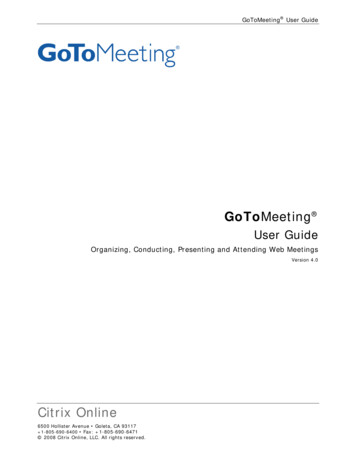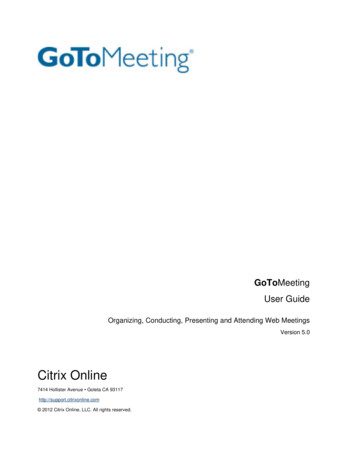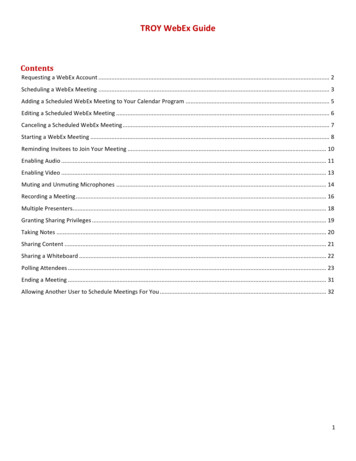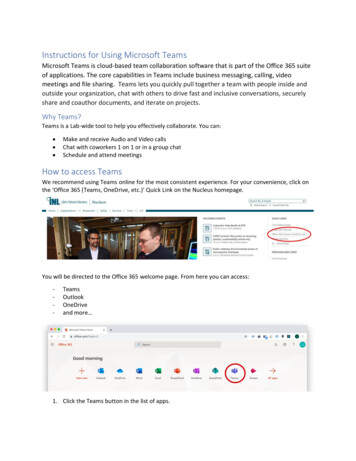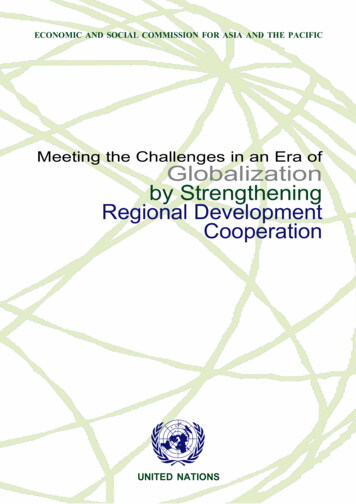
Transcription
ECONOMIC AND SOCIAL COMMISSION FOR ASIA AND THE PACIFICMeeting the Challenges in an Era ofGlobalizationby StrengtheningRegional DevelopmentCooperationUNITED NATIONS
ESCAP WORKS TOWARDS REDUCING POVERTYAND MANAGING GLOBALIZATION
ECONOMIC AND SOCIAL COMMISSION FOR ASIA AND THE PACIFICMeeting the Challenges in an Era ofGlobalizationby StrengtheningRegional DevelopmentCooperationUNITED NATIONSNew York, 2004
ST/ESCAP/2319UNITED NATIONS PUBLICATIONSales No. E.04.II.F.24Copyright United Nations 2004All rights reservedManufactured in ThailandISBN: 92-1-120378-3The designations employed and the presentation of the material in thispublication do not imply the expression of any opinion whatsoever on the partof the Secretariat of the United Nations concerning the legal status of anycountry, territory, city or area or of its authorities, or concerning the delimitationof its frontiers or boundaries.The opinions, figures and estimates set forth in this publication are theresponsibility of the authors, and should not necessarily be considered asreflecting the views or carrying the endorsement of the United Nations.Mention of firm names and commercial products does not imply theendorsement of the United Nations.ii
ForewordIn a period of growing global economic interdependence, regional cooperation offers Asia-Pacific countries an effective vehicle for achieving fastereconomic development. This study on the theme topic “Meeting the challengesin an era of globalization by strengthening regional development cooperation”,prepared for the sixtieth session of the Commission (Shanghai, China, 22-28April 2004) examines ways in which regional cooperation can contribute toboth regional and national shared interests and prosperity, consistent with themultilateral framework.Globalization has become an unstoppable phenomenon affecting all aspectsof our lives. But not all countries are receiving the benefits. An urgentchallenge is to draw on the considerable strengths of the Asia-Pacific region inpromoting economic prosperity to achieve internationally agreed developmentgoals, including those contained in the United Nations Millennium Declaration.The Asia-Pacific region is the most economically vibrant region in theworld, with a huge reservoir of resources – human, financial and technological.The goal is to use regional cooperation more effectively to reduce poverty, theregion’s greatest development challenge. Against this background, the studyexamines the regional cooperation arrangements employed in the four growthenhancing areas of trade, transport, information and communication technology,and finance. The state of progress in regional cooperation in these areas and thefuture potential are assessed.Over the years, ESCAP has contributed to promoting regional developmentcooperation in a wide range of areas. Some examples of its efforts in thisdirection are building the capacity of countries to prepare for WTO membership,forging intersubregional cooperation, as reflected in the Bangkok Agreement,and facilitating the Asian Highway network agreement. The findings includesuggestions for enhancing ESCAP’s role in regional development cooperation.In an era of rapid globalization, it is my hope that this study will drawattention to areas where regional cooperation can be further strengthened.Kim Hak-SuExecutive Secretaryiii
AcknowledgementsThis study, Meeting the Challenges in an Era of Globalization byStrengthening Regional Development Cooperation, has been prepared by ateam of staff members of the Poverty and Development Division of ESCAPunder the direction of Raj Kumar and with the work coordinated by HirenSarkar.Experts from within and outside the ESCAP secretariat contributed atvarious stages in the preparation of the report. Raj Kumar and Hiren Sarkarreviewed the study outline, various drafts and also contributed to the writing ofindividual chapters. Amarakoon Bandara and Biswajit Nag were the authorsof the major part of the study. The finance chapter was prepared from inputprovided by Yung Chul Park, who has been working as a consultant to theDivision.Experts’ comments and advice on selected draft chapters areacknowledged. The experts who attended the Expert Group Meeting onDevelopment Issues and Policies, held at Bangkok from 17 to 19 December2003, were: Stephen Y.L. Cheung (Hong Kong, China), George Manzano(Philippines), Yung Chul Park (Republic of Korea), Richard Pomfret (Australia),H.K. Pradhan (India), Binayak Sen (Bangladesh) and Viktoria Ter-Nikoghosyan(Kyrgyzstan).Other members of the ESCAP secretariat who were consulted ondifferent sections of the study pertaining to their particular areas of expertisewere Barry Cable, Xuan Zengpei, Ravi Ratnayake, Pranesh Chandra Saha,Tiziana Bonapace and Nokeo Ratanavong. Andrew Flatt provided usefulcomments and suggestions on data presentation. Other staff memberswho contributed inputs to the report include Wu Guoxiang, Kohji Iwakami,Harishchandra Iyer, Fuyo Jenny Yamamoto, Nuankae Wongthawatchaiand Meriem El Harouchi, Fullbright Fellow attached to ESCAP. KiatkanidPongpanich provided research assistance. In addition, Poverty and Development Division staff Shahid Ahmed, Muhammad H. Malik and Nobuko Kajiuraalso contributed in various ways during the preparation of the study. Thestudy was edited by Nicholas Cumming-Bruce. Nuankae Wongthawatchaicontributed to the cover design and layout.The logistics of processing and production and the organization ofthe Expert Group Meeting were handled by Dusdeemala Kanittanon,Woranut Sompitayanurak, Orawan Singho and Aoyporn Chongchitkasem.iv
ContentsPageForeword .iiiAcknowledgements .ivAbbreviations .xivIntroduction .1I.Globalization: opportunities and challenges .5A.New forces driving globalization .5B.Globalization: the Asia-Pacific situation .71.Trade .92.Finance .93.Communication .104.Transport .115.Income and poverty .116.“Divides” in the Asia-Pacific region .13The challenge of national economic policy in an era ofglobalization .16The challenges of globalization: multilateral responses .19Regional cooperation: conceptual framework andAsia-Pacific experience .23Introduction .23A.Rationale for regional cooperation .24B.Regional cooperation and interlinkages amongdifferent sectors .25C.Regional cooperation in a globalizing world .26D.Asia-Pacific experience of regional cooperation .281.Features and dynamics of Asia-Pacific regional cooperation .282.Structure and objectives of selected subregional groupsin Asia-Pacific .32Future of regional cooperation in Asia-Pacific .351.Integrating diverse economies .352.Important issues for future cooperation .363.Can Asia-Pacific go the EU way? .36C.D.II.E.v
Contents(continued)PageIII.Regional cooperation in trade .41Introduction .41A.World Trade Organization and Regional TradingArrangements .42B.Structure and trends of Asia-Pacific RTAs .44C.Analysis of selected regional trade and investmentagreements .501.Salient features of selected agreements .502.Intra-bloc trade in the region .533.Interaction among countries and subregionsin trade and investment areas .55D.Regional trade and concerns of developing countries .58E.Issues in strengthening cooperation in trade and investment .591.Improving the effectiveness of trade agreements .592.Cooperation beyond trade .603.Roles for large and small countries .604.Synthesizing RTAs with a multilateral process: important issues .60ESCAP’s future role .611.Multilateral trade and investment cooperation track .622.Regional trade and investment cooperation track .623.Bilateral trade and investment cooperation track .63Regional cooperation in transport .65Introduction .65A.Issues in transport cooperation .68B.Selected regional cooperation in the transport sector .711.Transport cooperation in ASEAN .712.Cooperation in transport and related issues in ECO .733.Transport cooperation in Pacific island countries .744.Transport and infrastructure development cooperationin SAARC .745.ESCAP’s initiatives in transport cooperation .756.Other important initiatives in the region .80F.IV.vi
Contents(continued)PageC.Observations on regional cooperation in the areaof transport .81ESCAP’s future role in transport .821.Strengthening transport networks through regional cooperation .822.Improving information and skills for transport planning .823.Reducing barriers to transport .834.Future regional cooperation in the transport sector .83Regional cooperation in information and communicationtechnology (ICT) .85Introduction .85A.Analysis of selected regional cooperation in ICT .901.ICT cooperation in ASEAN .912.ICT cooperation in Pacific island countries .923.ICT cooperation in SAARC .934.ESCAP’s initiatives on ICT .94Promoting further regional cooperation in the area of ICT .96Financial cooperation in Asia and the Pacific .101Introduction .101A.Existing financial cooperation in Asia-Pacific .1031.Developments in response to the 1997 Asian crisis .1032.Cooperation among central banks .1103.Cooperation in insurance .1114.Development financing arrangements .112Prospects for future financial cooperation in theAsia-Pacific region .113D.V.B.VI.B.1.Mobilization of domestic and international resourcesfor development .1132.Addressing systemic issues .1153.Financial infrastructure development .1174.Securitization of SME bonds .120vii
Contents(continued)PageC.D.Looking ahead: a vision for financial development andintegration in Asia and the Pacific .1211.Financial modernization and integration .1212.An Asian monetary fund: can the region justify its case? .1233.Currency union: a long-term vision? .124A possible role for ESCAP in promoting financialcooperation .1241.viiiBuilding channels of communication and policy dialogue:making ESCAP a “knowledge centre” .1252. Concluding remarks .125VII. Regional cooperation: forging a common vision .127
BoxesPageI.1.Selected messages from global consensuses on variousareas of globalization and development .20II.1.Resolution on the establishment of the Asian Development Bank .29II.2.South-South cooperation .30II.3.The Greater Mekong Subregion Programme .31II.4.European integration .37III.1.WTO obligation and outward orientation of RTAs .43III.2.Economic partnership agreements .46III.3.Bangladesh-India-Myanmar-Sri Lanka-Thailand EconomicCooperation .47III.4.Framework Agreement on the South Asian Free Trade Area .52III.5.Bangkok Agreement .57IV.1.Asian land transport infrastructure development .67IV.2.Towards Asia-Pacific natural gas transportation grids:developing regional cooperation .79Using ICT to achieve the Millennium Development Goals:some Asian experiences .86V.2.World Summit on the Information Society .89V.3.Women and the Internet .95V.4.Cooperation in ICT to achieve the Millennium DevelopmentGoals: developing a global partnership for development .96Satellite communication and broadband: transcending barriers .99V.1.V.5.ix
TablesPageI.1.Indicators of globalization .8I.2.Indicators of development .12III.1.Main features of preferential trade agreements .42III.2.Intra-bloc export shares of selected preferential trade agreements,five-year average, 1980-2000 .53Progress on the Chiang Mai Initiative .104VI.1.x
FiguresPageI.1.Gross national income per capita to trade share .14I.2.Gross national income per capita to inward stock of foreigndirect investment .14I.3.Gross national income per capita to intensity of Internet users .15I.4.Gross national income per capita to intensity of telephoneand mobile phone users .15II.1.Regional cooperation in different sectors and their interlinkages .26III.1.Kaleidoscope of selected Asia-Pacific trade agreements .49III.2.Percentage increase in trade with the world and partners(Bangkok Agreement countries compared with AFTAand SAARC countries) .56Consolidating BTAs among BIMST-EC and Bangkok Agreementmembers: An example towards future integration .62Bridging the digital divide and regional cooperation .90III.3.V.1.Annex figure VII.1.Two-tier securitization scheme for SME financing .157Annex figure VII.2.An example of securitization .158xi
MapsPagexiiAsian Highway route map .76Trans-Asian railway network map .77ESCAP region .134
AnnexesPageI.Selected major agreements and other cooperation arrangements .135II.Selected trade and investment agreements in the region .140III.Other important initiatives in the area of ICT .147IV.Regional strategy for ICT proposed by ESCAP .150V.Structure of the Chiang Mai Initiative .153VI.Credit guarantees and credit guarantee agencies .155VII.Securitization of SME bonds .156xiii
AbbreviationsxivADBAsian Development BankAFTAASEAN Free Trade AreaAPECAsia-Pacific Economic CooperationAPTAsia-Pacific TelecommunityAPTAAsia-Pacific Trade AgreementASEANAssociation of Southeast Asian NationsBTAsbilateral trading arrangementsECEEconomic Commission for EuropeECOEconomic Cooperation OrganizationESCWAEconomic and Social Commission for Western AsiaEUEuropean UnionFDIforeign direct investmentGATSGeneral Agreement on Trade in ServicesGATTGeneral Agreement on Tariffs and TradeGDPgross domestic productGNIgross national incomeGNPgross national productICSTinformation, communication and space technologyICTinformation and communication technologyIMFInternational Monetary FundITinformation technologyITUInternational Telecommunication UnionMFNmost-favoured-nationODAofficial development assistancePPPpurchasing power parityPTAspreferential trading arrangementsRTAsregional trading arrangementsSAARCSouth Asian Association for Regional CooperationSMEssmall and medium-sized enterprisesUNCTADUnited Nations Conference on Trade and DevelopmentUNDPUnited Nations Development ProgrammeUNESCOUnited Nations Educational, Scientific and Cultural OrganizationWTOWorld Trade Organization
INTRODUCTIONGlobalization is a complex, multidimensional and unevenprocess through which goods and services, capital, people,information and ideas flow across borders, leading to greater integrationof economies and societies. The benefits are clearly visible in theincreased trade, higher growth and falling poverty of countries fullyengaged in the process. Globalization, however, has become controversial precisely because of the uneven distribution of its benefits andits equally visible negative impacts in countries where it has caused joblosses, rising income disparity and environmental challenges.Globalization is acomplex, uneven andhence controversialprocessThe Asia-Pacific region vividly illustrates this phenomenon.It spans countries which have been among the most vigorous adherentsand major beneficiaries of globalization. The newly industrializedeconomies (NIEs) such as Hong Kong, China; the Republic ofKorea; Singapore; and Taiwan Province of China, together withemerging South-East Asian countries, like Malaysia and Thailandhave experienced high growth rates, improved living standards andan impressive drop in poverty. The number of poor in East Asiaand the Pacific dropped from 457 million in 1990 to 282 million in1999.1However, the region contains many other countries, including leastdeveloped and landlocked countries, small islands and transitionaleconomies, whose lack of infrastructure, resources and skills leavesthem unable to compete in fast-paced world markets or exploit theopportunities presented by globalization. In the face of falling commodityprices and protectionist trading practices, they are at risk of becomingincreasingly marginalized in the world economy.Emerging socio-economic and geopolitical issues add to thecomplexity of the international business environment. The presentglobal security climate and the associated costs it imposes on the free1 World Bank, “East Asia update: regional overview, October 2003”, 03.pdf , 20 November 2003.1
Meeting the Challenges in an Era of Globalization by Strengthening Regional Development Cooperationflow of goods, services and people threaten to act as further constraintson developing countries’ ability to reap the benefits of globalization.Lack of regional and international cooperation arrangements has led toexcessive transaction costs and rent-seeking in international migration,an important source of foreign exchange for many developing countriesin the region and a source of low-cost labour for host economies.Outbreaks of disease in the absence of effective surveillance mechanisms, collaborative research or the supply of drugs at affordable pricescould hurt or reverse the development process in affected countries, asseen in the case of HIV/AIDS.The challenge is how tomanage globalization;regional cooperationcan helpSo what options are available to policy makers? Is South-Southcooperation useful either as a defence against the negative falloutfrom globalization or for exploiting its benefits? Should globalizationbe discarded altogether? The Millennium Summit made it clear that theimportant debate is not whether globalization is good or bad but how itshould be managed to make it a vehicle for broad-based development.The present study analyses how strengthening regional developmentcooperation can contribute to that result.The rewards from exploiting globalization can be substantial.Openness to international trade and investment facilitates the acquisitionof inputs and technologies which strengthen growth and increaseefficiency. Access to wider markets and more diverse exports reducethe risks of trade volatility and exclusion by particular country markets.Openness to the free flow of capital helps to attract FDI, whichcan stimulate domestic investment, thus contributing to employmentgeneration and economic growth. Financial openness also helps toincrease the depth and breadth of domestic financial markets, leading toincreased efficiency in financial intermediation through lower costs andimproved resource allocation.But globalization also carries risks and sometimes heavy social andeconomic costs, as Asia’s 1997 financial crisis starkly revealed. Opennessto global capital markets leaves domestic financial markets vulnerable tosudden shocks, leading to greater volatility in exchange rates and abruptreversal of financial flows, particularly in countries where financialsystems are weak and economic policies lack credibility. Trade liberalization has left many developing countries marginalized as demand fortheir unskilled labour and real wages fell. Fear of job losses because ofcheap labour in developing countries has heightened the sense of vulnerability among blue and white collar workers in industrialized countries.Many countries lack either the resources or the skills to upgradeproduction technologies, widening the technological gap between industrial and developing countries. This compels them to continue to dependon primary commodity exports, with the well-known structural problems2
Introductionassociated with them.2 Moreover, developing countries’ access to capitalmarkets tends to be asymmetric: they are able to borrow only in “good”times and face severe credit constraints during “bad” times.Managing globalization to maximize the benefits and minimizethese potential costs depends as much on political will as on marketforces and new technologies. The factors within the control of policymakers, such as structural reforms, ensuring consistency in policies,transparency and good governance, support this strategic aim. Theeconomies that gained the most from globalization are those, like EastAsia’s NIEs, that adjusted their policies and institutions to exploit it.At the Fourth WTO Ministerial Conference, the InternationalConference on Financing for Development and the World Summit onSustainable Development, a global consensus was forged on prioritiesand policies for a new partnership for development between developedand developing countries aimed at accelerating economic growth, reducingpoverty and promoting sustainable development so that the benefits ofglobalization could be shared by all. The Doha Development Agenda isaimed at establishing a development-friendly multilateral trading system.The Monterrey Consensus pledged action on domestic, international andsystemic policy issues, in particular those relating to financing for development. It made a further commitment to enhance the role of regional andsubregional agreements and free trade areas consistent with the multilateral trading system. The World Summit also supported the emergence ofstronger regional groupings and alliances to promote regional cooperation, improved international cooperation and sustainable development.The Asia-Pacific region can draw on considerable strengths in thetask of bringing poor and marginalized countries into the developmentprocess and ensuring that global development agendas work for them.First, the region’s level of savings has been the highest in the world.Over the past five years, the total combined savings of the 10-countryAssociation of Southeast Asian Nations together with China, theRepublic of Korea and Japan (ASEAN 3) have accounted, on average,for 19.7 per cent of global savings and are larger in absolute terms thanthose of the European Union. Second, the region has a large accumulation of foreign reserves. The total foreign reserves of ASEAN 3alone amounted to 1.9 trillion at the end of 2003. Third, the regioncontains Japan, the second-largest economy in the world, and two largeand populous economies, China and India, which could serve as stimulito growth in the region. Growth in income and demand arising withinAsia and the Pacific is expected to provide a powerful driving force fordevelopment in the region.The Asia-Pacificregion needs to buildon its strengths, whichare many2 The structural problems faced by primary commodities producers include falling relativeprices and increasing protectionist measures by industrialized countries, which negate the benefits ofcompetition for developing countries.3
Meeting the Challenges in an Era of Globalization by Strengthening Regional Development CooperationRegion’s reservesinvested abroad whilepoorer countries faceresource gapBut the region also contends with weaknesses. It is home to twothirds of the world’s poor. Many countries in the region have yet tointroduce the economic policies, institutions and standards of governanceneeded to exploit the benefits of globalization. The lack of physical andsocial infrastructure and limited access to financial capital hinder manyof the region’s developing countries. So do poor standards of governance, transparency and accountability and low regard for the environment. The region continues to lend a large part of its savings to theindustrialized world to finance their investments at the same time asmany developing countries in the region face difficulties in mobilizingdevelopment finance. The region’s large foreign exchange reserveshave been invested mainly in low-return safe assets in more advancedcountries, particularly the United States of America, and are recycledback into the region at a higher cost in the form of short-term capital,with potentially destabilizing effects on financial markets in times ofdistress.In a period of growing global economic interdependence, regionalcooperation offers Asia-Pacif
iv Acknowledgements This study, Meeting the Challenges in an Era of Globalization by Strengthening Regional Development Cooperation, has been prepared by a team of staff members of the Poverty and Development Division of ESCAP


